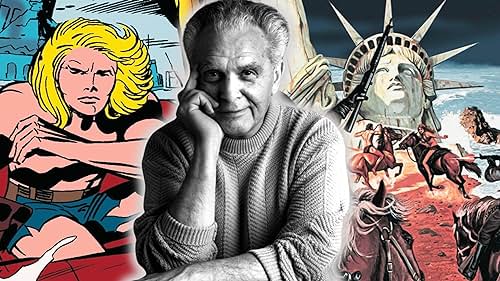Following the success of 1968’s Planet of the Apes movie, Marvel and DC Comics fought over the rights to publish comics based on the film. When the latter lost, the legendary Jack Kirby was commissioned by DC editorial to create his own version. Despite it being labeled a rip-off, Kirby actually got there first.
In 1963, Pierre Boulle published his original The Planet of the Apes novel. Soon after, Charlton Heston headlined the blockbuster adaptation, which became one of the decade’s most influential and iconic films. Considering this success, it was only a matter of time before comic book publishers tried to cash in. Famously, Marvel Comics secured the rights and turned in both a movie adaptation and a well-remembered series, with Doug Moench, Mike Ploog and Gerry Conway working on the run. Over at DC, however, Jack Kirby created something even better: Kamandi: The Last Boy on Earth.
In Jack Kirby’s Kamandi, readers were given a blend of high fantasy, historical allegory, science fiction and adventure, replete with monsters and talking animals. The X-Men co-creator used his own ideas, and the concept actually predates Boulle’s original novel.
Rather than stopping with the idea of apes as the planet’s dominant species, Kirby instead followed myriad animal civilizations, each one a window into old human cultures. Where the Tiger Kingdom is a clear allegory for the Roman Empire, the Sea Leopards are swashbuckling pirates. Bats, apes, lions and snakes are also among the species that ascended to human-like intelligence, and Kirby played on how humans anthropomorphize each creature.
Although Carmine Infantino did ask Kirby to create something to compete with Planet of the Apes, the core elements of Kamandi actually date from before Pierre Boulle’s novel. The King of Comics was exploring the concept as far back as 1957, through his story “The Last Enemy,” which he created for Harvey Comics’ Alarming Tales. This short story follows a human time traveler in the future, where he’s confronted by walking, talking animals, such as rats and dogs. Kirby combined this with an unused strip called “Kamandi of the Caves,” and created Kamandi: The Last Boy On Earth.
The series follows Kamandi as he leaves the safety of an underground bunker, Command-D, and ventures out onto the new Earth. Following a “Great Disaster,” humans sought shelter underground, and the death of Kamandi’s grandfather left the young boy alone, with nothing left but to explore. After making his way into the world, he is caught in a skirmish between leopards and tigers, the latter of whom later become an integral part of Kamandi’s story. From there, the young hero begins his perilous trek across the new America, meeting a series of friends along the way.
One of the most unfair reputations in comics is the claim that Jack Kirby ripped off Boulle’s idea, when the reality is it was his from the start. While neither creator can claim to have originated the idea of talking animals, exploring a future Earth ruled by intelligent beasts comes from Kirby. At the time, his short story flew completely under the radar, but the success of the Planet of the Apes franchise shows it was always viable. Expanding this concept to a corner of a major superhero universe only leaves the door open to endless possibilities and genre versatility. Everything Boulle did well, Kirby did better.
FAQ
Did Jack Kirby plagiarize Pierre Boulle’s concept for Planet of the Apes?
No, Jack Kirby’s Kamandi: The Last Boy on Earth predates Boulle’s novel. Kirby had been exploring the concept of a future Earth ruled by intelligent animals since as early as 1957, with his story “The Last Enemy” published in Harvey Comics’ Alarming Tales.
How does Kamandi differ from Planet of the Apes?
While both explore a post-apocalyptic Earth where animals have evolved to become the dominant species, Kamandi goes beyond just apes and delves into a diverse range of animal civilizations, each reflecting aspects of human cultures. Additionally, Kamandi’s narrative incorporates elements of high fantasy, historical allegory, and adventure.
Why hasn’t Kamandi been adapted into other media, like film or television?
Despite its rich and expansive world, Kamandi has remained relatively obscure since its cancellation following the DC Implosion. However, fans have long clamored for an adaptation, believing it has the potential to rival or even surpass the success of franchises like Planet of the Apes.
